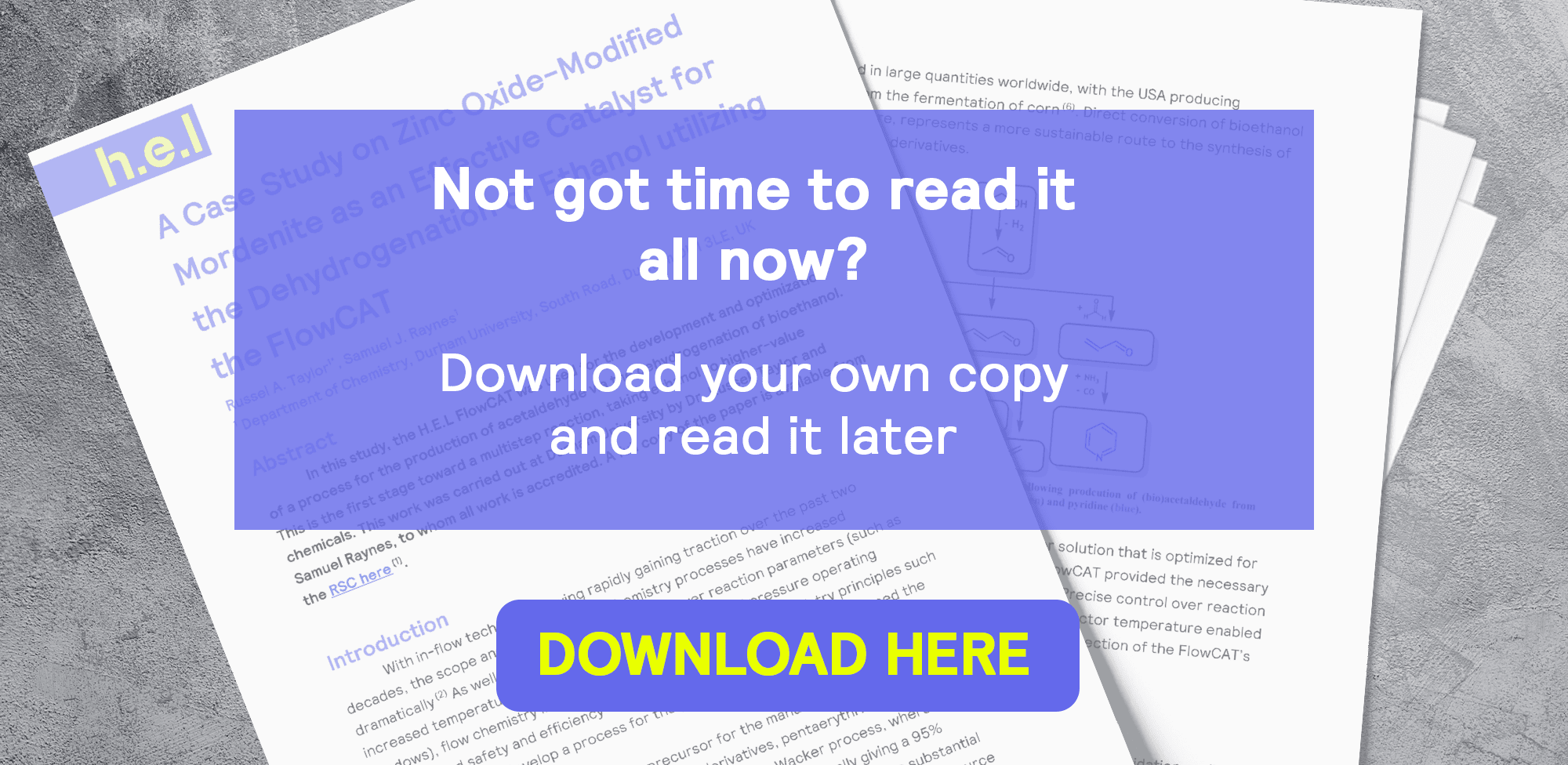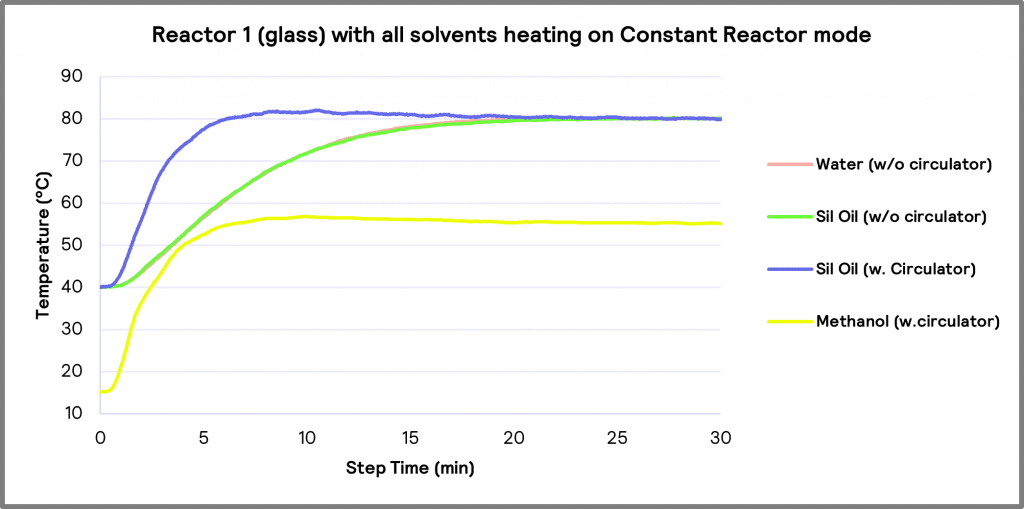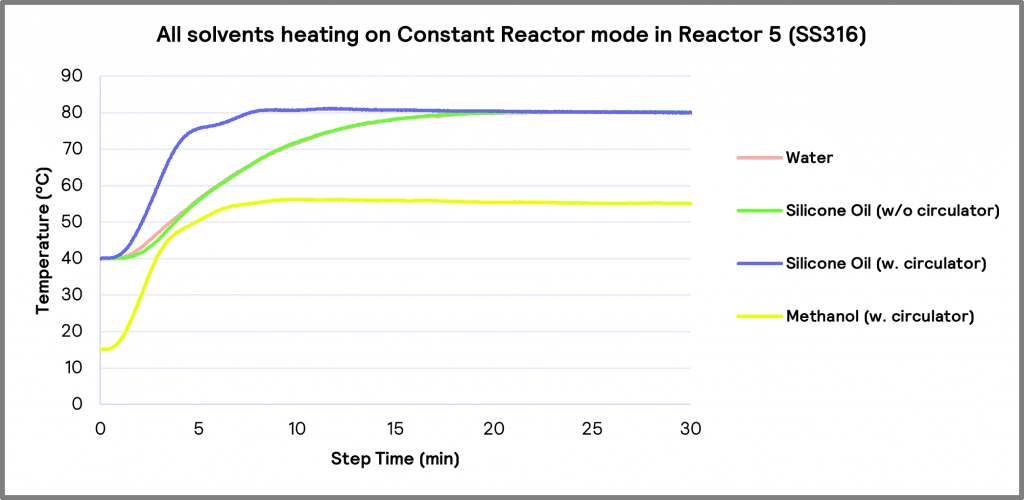Characterization of the heating performance for the multi-reactor PolyBLOCK 8
Aliko Chanda, Joseph Willmot
H.E.L Group, 9-10 Capital Business Park, Manor Way, London, WD6 1GW
This study investigated the temperature control capabilities of the PolyBLOCK parallel reaction block with different control modes, setting a constant reactor temperature or ramping the reactor temperature. Three different solvents were investigated in four different reactors. The solvents used varied in boiling point, heat capacity, and viscosity. Connecting a silicone oil circulator showed optimum temperature control characteristics.
Introduction
The PolyBLOCK 8 is a parallel reactor block with in-built heating, cooling, and stirring capabilities. It can operate as a stand-alone reactor system, and it is also found in many other products such as the ChemSCAN or BioXplorer range. The PolyBLOCK 8 has eight independently controlled reaction zones in a compact footprint. Depending on the intended use, the reactor vessel will typically be glass or metal. Glass is often used for general synthesis and laboratory work, metal – typically SS316 or HC276 – for high-pressure applications.
This study demonstrates the heating capabilities of the PolyBLOCK 8 by testing temperature control methods with various solvents and reactors. Thereby providing a valuable guide to selecting the right combination of these factors when designing an experiment.
Materials and Method
The PolyBLOCK 8 in this study is used in standard laboratory conditions, controlled via labCONSOL® software. In all experiments, glass reactors with PTFE lids of 50 mL, 100 mL, or 150 mL volume were placed in mantles 1 to 4 while positions 5 to 8 had SS316, 200bar rated metal reactors of either 16 mL or 50 mL volume. – Detailed in Table 1.
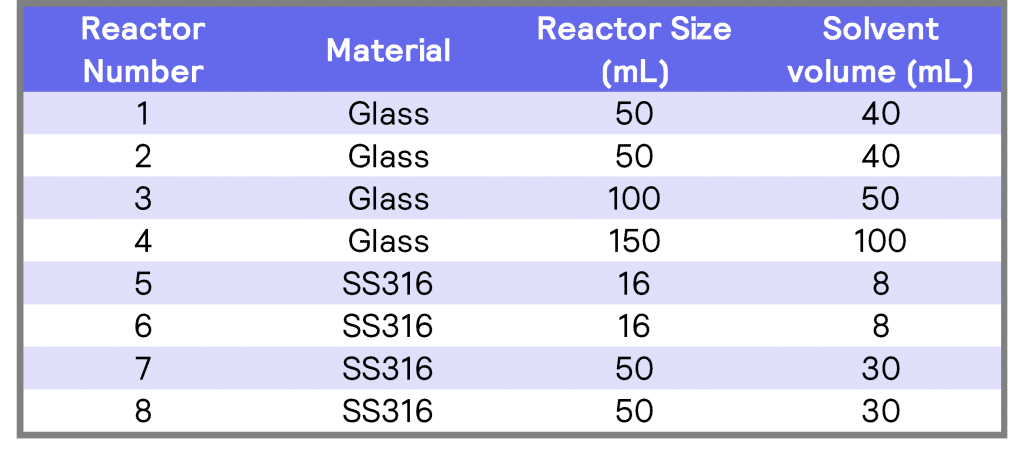
Table 1. Details of all reactors, including size material of reactor and solvent volume.
Deionized water (with a conductivity below 5 µS), Methanol (CAS no.: 67-56-1), and Silicone oil (Huber P20-275- 50) are the solvents used for these tests. Six-blade PTFE Rushton impellers were used in the glass reactors, and SS316 anchor impellers were used in the metal reactors. In all cases, stirring is provided via magnetically coupled agitation provided by the PolyBLOCK in-built magnetic stirrer at 400 rpm. In addition, a Huber Unistat 430 was attached to the PolyBLOCK to provide active cooling.
Results and Discussion
The labCONSOL® software can operate the PolyBLOCK in various modes, such as Heat/Cool Reactor (ramping reactor temperature) or Constant Reactor Temperature.
Heat/Cool Reactor changes the reactor temperature at a defined rate -see figure 1 for example.
In contrast, Constant Reactor Temperature Control (figure 2) heats the reactor contents to a specified temperature as quickly as possible. Both heating modes were investigated.
For ease of interpretation, example data from the following reactors will be shown: R1 (glass), R4 (glass), R5 (SS316), and R8 (SS316).
 |
 |
| Figure 1. Heat/Cool Reactor plan heating by 2 °C/min to 80 °C | Figure 2. Step of Constant Reactor heating to 80 °C |
Evaluation of water as a solvent, without active cooling
Water is a widely used solvent due to its polarity and capability to dissolve various substances. In these studies, no active cooling was provided to the PolyBLOCK through a circulator. The reactors were heated to a maximum setpoint temperature of 80 °C, to avoid evaporation of the solvent.
Plans containing a mixture of the Constant Reactor and Heat/Cool Reactor modes were applied to all reactor positions.
R1 and R5 tested Constant Reactor temperature mode, while R4 and R8 tested Heat/Cool reactor temperature mode.
The data from R1 and R5 (Constant Reactor mode) showed very little difference; both achieved stable (±0.1 °C) reactor temperature control at 80 °C within 20 minutes, giving an average rate of change of 4 °C/min. R4 and R8 (Heat/Cool Reactor mode) took 28 minutes to stabilize at 80 °C whilst ramping at 4 °C/min, 8 minutes longer than Constant Reactor mode. These reactors also had a detectable temperature overshoot which can be compensated for using an external cooler attached to the system.
These results highlight the differences in Constant Reactor and Heat/Cool Reactor modes when no active cooling is attached to the PolyBLOCK. The material of the reactor and the solvent volume have a negligible impact on the temperature control performance. These results also demonstrate the consistency of heating between different positions when running the same plan.
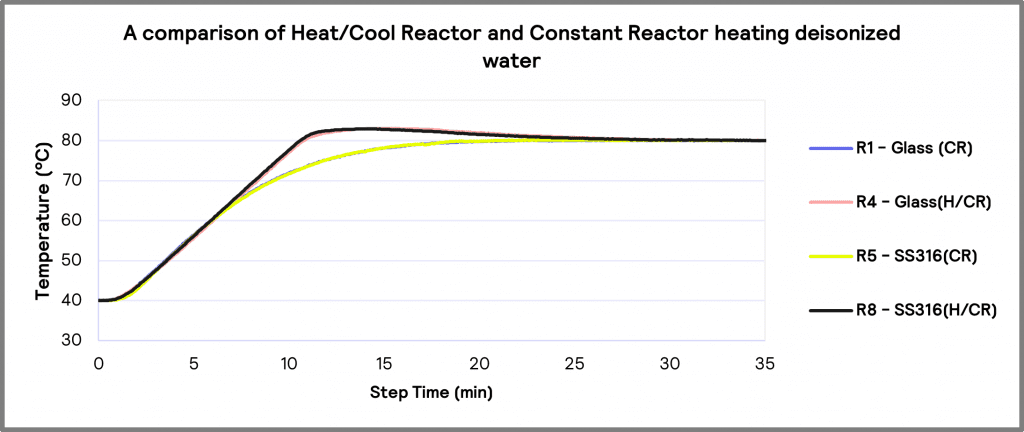
Graph 1. A comparison of Heat/Cool Reactor (H/CR) and Constant Reactor (CR) Temperature modes for heating water
Evaluation of water as a solvent, with active cooling
Compared to the data obtained from the samples without active cooling, there are some differences in heating performance.
- When heating Silicone oil, all reactors get to temperature within 10 minutes of the temperature control starting (Graph 2)
- Temperature overshoots are significantly reduced or even eliminated
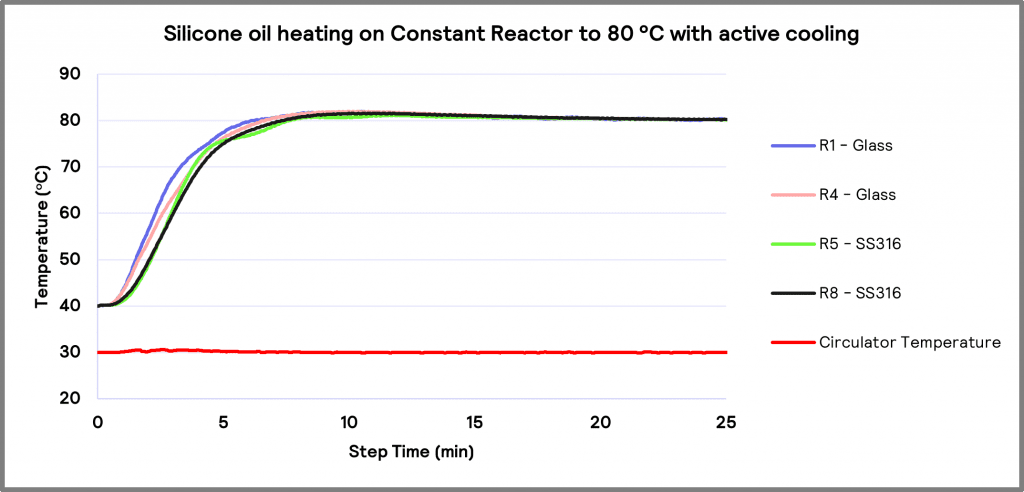
Graph 2. Silicone oil heating using Constant Reactor control, with active cooling.
Heating alternative solvents
As well as water, heating of both Silicone oil and Methanol was investigated. Silicone oil has the widest operating temperature range of the three solvents tested, enabling testing of higher temperature setpoints Whereas Methanol has the lowest boiling point of the three solvents at 64.7 °C.
The data in graph 3 shows a comparison of all three solvents in the glass reactor R1. For this study, Methanol was heated to 55 °C, Silicone oil and water were heated to 80 °C. The Silicone oil was heated both with and without an external circulator.
The results showed that methanol achieved a 40 °C temperature increase at 5 °C/min in 8 minutes. Silicone oil (with circulator) performed similarly with a slight overshoot and took 20 minutes to reach the set temperature. The results also demonstrate greater heating rates were achieved when an external circulator was used. These samples also showed little-to-no temperature overshoot.
Data from the stainless-steel reactor show similar results (Graph 4).
Conclusion
Having different modes of reactor temperature control is highly advantageous as applications will often require different rates of heating. These modes are helpful for solvents or reactants that are highly sensitive to temperature. This work highlights the differences between two heating approaches available on the PolyBLOCK 8, with and without an external circulator connected.
Active cooling reduces the possibility or significance of overshoots when heating on Heat/Cool Reactor mode.
This study also demonstrates that temperature control is largely unaffected by reactor volume or material. It is expected that solvents with similar heat capacities, boiling points, and viscosities will behave similarly to those in this study.
Acknowledgments
We want to thank the contribution of Dr. Paddy Delaney, for lending us a Huber Unistat 430 for these characterizations and other applications.

